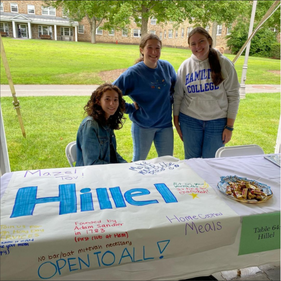Through Innovation, Small Colleges Bring Big Jewish Community

Hamilton College is located in Clinton, N.Y., a historic village that claims the tagline, “Small town, big community.” Hamilton has a student population of 1,850, only fifty people less than the village itself. The closest large city is Syracuse, about an hour away by car. Despite the distance from urban areas, Hamilton Hillel, known as the “Hillel on a Hill,” provides a thriving, diverse community for its Jewish students. Hillels like Hamilton’s are changing the narrative about finding strong Jewish communities in small colleges and towns.
The notion that students have to attend a densely-Jewish area to keep connected to a Jewish community is a tired one. Students from both urban and rural areas have found a home at the Hillel on a Hill. For some students, the number of Jewish peers at Hamilton is shocking, says Hamilton College’s resident rabbi and executive director, Rabbi Ethan Bair: “I have met several Jewish students who come from places with even smaller Jewish communities than Hamilton College.”
Those rural students then have the opportunity to connect with a Jewish community for the first time, while students from bigger cities come to a different realization. “These students are so happy realizing that there are many Jewish students in all of their classes. Meanwhile, students from New York City realize, ‘Oh wow, Jewish culture is not the default,’ and if they want Jewish community, they have to create it,” Rabbi Bair said.
Zoe Levine, a Social Justice Springboard Fellow at Oberlin College, also notices the diversity of practice within their smaller population of Jewish students: “There is a really large mix of students who were engaged in their Jewish communities growing up and those who are just getting connected to a Jewish community now,” Levine says.
Oberlin College is another example of a smaller school with a big community. The school has about 3,000 students – the size of some U.S. public high schools — and is a notable music conservatory and liberal arts school. However, the size of the general student population doesn’t reflect the size of the Jewish population. Levine noted that the number of Jewish students is relatively high, even compared to some larger, urban universities. Nearly a third of the student population, Levine says, identifies as Jewish.
Like Rabbi Bair’s students, Oberlin Hillel students are creating their own community and Judaism by seeking out the familiarity of Hillel or exploring Hillel and Judaism for the first time. As Levine suggests, small colleges are a place where students can more easily pick and choose what they want their Jewish life to look like.
Part of that ease comes from innovative community-building strategies that promote self-discovery. Hamilton Hillel, for example, celebrated Simchat Torah in collaboration with the rare book specialist on campus. Hamilton, Rabbi Bair said, has a “unique, 120-year-old Torah with multiple handwritings and styles.” The variation of styles implies that the Torah itself was a collaboration. This campus event garnered attention from Jewish students, non-Jewish students, and non-Jewish literature professors. The Hillel on a Hill also works with the Muslim Student Association (MSA) to further the bonds between the two minority religions. Fewer Jewish students on campus means students need to think “outside the box” when building a community.
Asked where the nickname, “Hillel on a Hill” came from, Rabbi Bair dispels notions of the lone Hillel building sitting upon vast, misty green hills with nary a home in sight. Quite the opposite: the Hillel building is actually on College Hill Road, the main street of the campus. The nickname serves as a reminder that a Jewish community isn’t only found at a large university housed in an urban setting. It’s also found in smaller locales, where people use their available resources to create a community as rich as any large university – and students from all walks of life would do well to take a closer look.